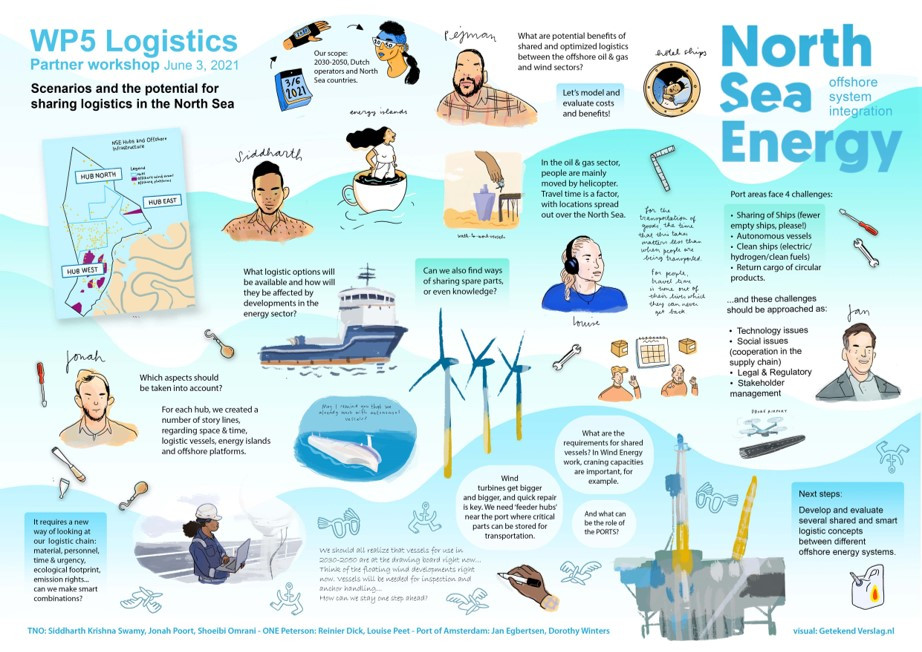INTERVIEW Pejman Shoeibi Omrani
November 22, 2021
Each month NSE interviews one of its program members. This month we talked with Pejman Shoeibi Omrani from TNO who leads the work package on Logistics.
The North Sea Energy (NSE) program goal is to deliver a roadmap for offshore system integration in the North Sea towards 2050, by the end of 2022. Logistics play a significant role in the safe and efficient operation of the offshore energy system. The offshore energy sector is currently facing major changes as a result of the planned decline in offshore gas production and the rapid growth of offshore wind energy. We interviewed Pejman Shoeibi Omrani, senior scientist at TNO. Pejman has been involved in the NSE program and leads the work package on logistics.
Pejman, what is the main challenge of offshore logistics? What solution is your work package working on to tackle this challenge?
Looking into the plans and activities in the North Sea we see several trends; from the decline of oil and gas and the expansion of offshore wind, to the re-use of offshore platforms for CO2 storage or hydrogen production and the potential creation of artificial energy islands. Offshore logistics provides the backbone to all these activities, ensuring that all stages of the technological lifecycle (construction/conversion, operation and maintenance, and re-use/decommissioning) run as smoothly as possible. There we have several challenges mainly due to the fact that each party is developing their own logistic ecosystem. Sub-optimum orchestration and synergy in providing services in an integrated energy system will impact overall cost, emission and efficiency. Not to forget that digital technologies will have a significant role in improving the synergy and orchestrating the logistics services.
Just to give few figures, logistics account for around 20-25% of the total costs of operation and maintenance of offshore wind, sharing and optimization of the logistics system(s) can lead to considerable cost and emission reductions. Now curious to know how much savings can be made by further integrating the logistic services for different North Sea energy systems? Hopefully we will have an answer for this at the end of NSE 4 program.
The costs of maintenance are rising. How can these costs be contained?
As an example of potential cost savings, when oil and gas operators on the Dutch North Sea decided to pool their logistic needs and started routing vessels based on a geographic proximity basis instead of operator by operator basis, costs associated with vessel capacity decreased by around 20%. Similar and additional cost savings (up to 4-5% based on previously mentioned numbers for Operations & Maintenance (OM) activities alone) could be achieved.
Operators themselves are exploring and implementing digital technologies to be more proactive in the maintenance (from preventive to predictive) and hence minimize their downtime and costs associated with it.
Transport to the gas platforms and wind turbines is by ship. What is being done to keep these emissions to a minimum?
In addition to the sharing concepts that we are working on in the NSE program, there are currently very interesting and promising developments in the field of alternative fuels for vessels. Another aspects is the possibility of constructing an energy island which can have some functionalities to support the offshore logistics, for instance as a warehouse or technician base.
The world is rapidly digitalizing these days. How does digitalization play a role in offshore logistics?
There are lots of examples that can show how digitalization can enhance the current logistics planning and future developments. Technologies from secure data sharing to enable different stakeholders having access to the insights from others’ data without violating the privacy to artificial intelligence for better monitoring the critical processes and optimizing the O&M scheduling. In addition the raise of drone technologies for inspection and delivery of components could completely change the service approaches in the offshore. These are just few examples of the possibilities.
What else is interesting to mention about the offshore logistics work package?
We would like to take an additional step in demonstrating the added value of integrating digital technologies in the North Sea not only focused on the logistics but to support the energy system integration. And I have to say it is inspiring to have such a great team of experts from ONE Peterson, Port of Amsterdam and TNO working together in this work package.

